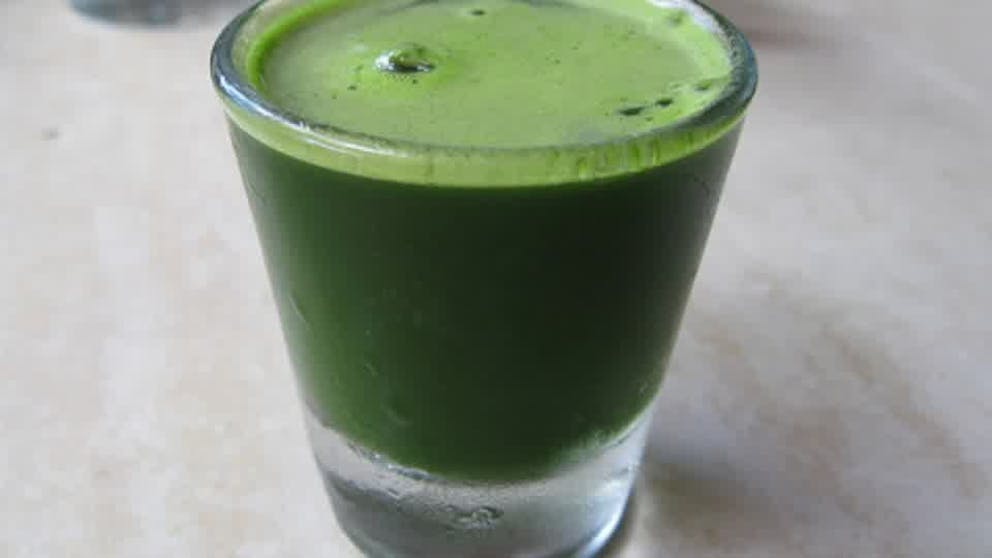The ONLY Wheat You Should Eat
The ONLY Wheat You Should Eat
Renowned for its mighty health perks, wheatgrass juice is celebrated as a miraculous superfood potion. From its inception to the best methods of intake, this beverage has captured the curiosity and skepticism of those interested in health.
Embarking on an exploration, we uncover the essence of wheatgrass juice's nutritional dynamism, from its absence of gluten to its scant presence of substances that could hinder nutrient absorption.
Opting for the liquid form rather than its powdered counterpart could amplify the nutritional advantages you're seeking.
Moreover, we tackle some intriguing research about how this green marvel might influence blood health positively. By the end of our exploration, you’ll understand wheatgrass better and grasp how incorporating it into your diet could offer more than just nutritional perks.
Wheatgrass 101: Understanding Its Origins and Growth
Embark on a journey to uncover the roots of wheatgrass and how it flourishes from seed to vibrant green blades. Dive into the fascinating history and cultivation methods behind this nutrient-rich superfood.
Explore wheatgrass's origins and growth process, unlocking insights into its remarkable nutritional benefits.
The Ideal Growth Phase
When it comes to harvesting wheatgrass, timing is everything. This power-packed plant reaches its nutritional peak in the microgreen phase about 7 to 10 days after planting. It's overflowing with nutrients, transforming into a titan of health benefits.
This early harvest doesn't just max out nutrient levels; it also avoids the more brutal textures and more intense flavors that come with older plants. So, if you're looking for the sweet spot of taste and nutrition, young wheatgrass has your back.
Soil vs. Other Mediums
Growing mediums matter more than you might think. While hydroponics sounds high-tech, soil-grown wheatgrass takes the crown for nutrient density.
The reason? With its intricate web of life, dirt nurtures plants and infuses them with micro-minerals unavailable through alternative techniques.
This isn’t just garden-variety advice—choosing soil as your growing medium ensures your wheatgrass is healthier and packs a more potent nutritional punch.

Wheatgrass Juice vs. Powder: What's the Difference?
Discover the nuances between wheatgrass juice and powder, delving into their unique characteristics and benefits. Explore the convenience and versatility of wheatgrass powder compared to the freshness and potency of its liquid counterpart.
Uncover which form aligns best with your lifestyle and health goals to harness the full potential of wheatgrass.
Concentration Levels Explored
The main difference between wheatgrass juice powder and its powdered greens counterpart lies in concentration due to fiber removal. When you strip away the fiber, what's left? A powerhouse of nutrients in a more concentrated form.
It's not merely about maximizing value; it's the essence of optimizing nutritional intake.
Imagine needing fewer scoops to achieve the same nutritional impact—this is what happens with wheatgrass juice powder since it lacks the fiber found in regular wheatgrass powder.
But choosing between these two forms depends on your goals. Wheatgrass juice powder might be your best bet if maximum nutrient density per serving sounds appealing.
Gluten-Free Goodness of Wheatgrass
Wheatgrass is a lighthouse, guiding individuals with gluten intolerance or celiac disease through the stormy sea of dietary restrictions. Unlike its fully-grown wheat counterparts, this superfood doesn't contain gluten because it's harvested in its juvenile phase.
This makes it a safe harbor for individuals needing to avoid gluten.
Wheatgrass, being free from gluten, unlocks a treasure trove of nutrients for those navigating the challenges of gluten sensitivities. Individuals grappling with celiac disease can relish the bounty of nutrients in this vegetation, free from apprehension.
For more information on managing celiac disease through diet, the Celiac Disease Foundation offers comprehensive guidance.
Wheatgrass is an alluring option for those looking at their waistlines and anyone wanting to maintain a healthy lifestyle while dealing with gluten-related dietary restrictions.
The Lowdown on Anti-Nutrients in Wheatgrass
Wheatgrass packs a punch with its nutritional benefits, but let's not forget about the anti-nutrients it carries. Before you raise your eyebrows, hear me out. Phytic acid, tannins, and oxalates might sound like party crashers, but they're in minimal wheatgrass levels.
Now, you might wonder why these so-called "anti-nutrients" matter. When present in hefty quantities, these substances can meddle with the process through which our bodies latch onto vital minerals.
But here’s the kicker - the tiny amount in wheatgrass doesn't threaten your mineral absorption game.
To put things into perspective, phytic acid, tannins, and oxalates are just like those uninvited guests at a party who end up being relatively harmless and keeping to themselves. So yes, you can enjoy that shot of wheatgrass juice without worrying about them too much.
Nutritional Profile and Health Benefits
Dive into its potential health benefits, including detoxification, immune support, and anti-inflammatory properties, making it a popular addition to health-conscious diets.
Incorporating wheatgrass into your regimen may promote vitality and wellness through its abundance of essential nutrients and health-boosting compounds.
Vitamins and Minerals Galore
Imagine your body as a high-performance vehicle. Like premium fuel makes that car run better, wheatgrass juice powers your body with an impressive lineup of vitamins and minerals.
This green powerhouse is low in carbs but packed with vitamin C, beta carotene, B vitamins, and trace minerals, and even contains B12 thanks to the microorganisms living within the plant.
The Power of Chlorophyll
Wheatgrass juice, tinged with the verdant hue of chlorophyll, isn't just a feast for the eyes but could very well be considered a tonic of vitality, brimming with health benefits. Its structure mirrors human blood—except magnesium sits at its core instead of iron.
This resemblance suggests chlorophyll can help ensure our red blood cells are up to snuff.
Phytonutrients and Their Effects
You've probably heard about antioxidants before—but did you know phytonutrients in wheatgrass work as nature's anti-inflammatory warriors?
They're good at putting out fires (inflammation), guarding against oxidative stress (damage from free radicals), and fighting off microbes trying to crash the party inside our bodies.

Wheatgrass Juice and Blood Health
Imagine a green elixir that could jazz up your blood health. That's wheatgrass juice for you, especially if we're talking about tackling thalassemia. Studies have hinted at its knack for boosting red blood cell production, thanks to the chlorophyll it packs.
The connection between wheatgrass juice and improved conditions in people with thalassemia isn't just talk.
There are promising results from alternative treatments showing significant improvements. It boils down to chlorophyll, which resembles our hemoglobin structure - minus the iron replaced by magnesium.
Those sipping this vibrant drink might find their bodies better equipped to produce those much-needed red cells. Amid ongoing studies, the preliminary findings offer optimism for those grappling with this inherited hematological condition.
Conclusion
So, diving into wheatgrass juice opens up a world of benefits. It's more than just a drink; it's a nutrient powerhouse.
Every sip has health perks, from its rich vitamin and mineral content to the incredible effects of chlorophyll that mirror human blood.
Wheatgrass Juice unfurls a plethora of advantages, encompassing far more than meets the eye.
This green marvel supports blood health and brings an army of phytonutrients to fight inflammation and boost your well-being.
Choosing juice over powder lets you maximize these nutrients in every drop. It’s gluten-free goodness, making it perfect for everyone to enjoy.
To wrap this up, make wheatgrass juice part of your diet. You’ll tap into nature’s secret elixir, enriching your body with everything from A to zinc.
Supporting Data
https://www.degruyter.com/document/doi/10.1515/jcim-2016-0053/html?lang=en
https://www.ncbi.nlm.nih.gov/pmc/articles/PMC5947926/
https://ascopubs.org/doi/abs/10.1200/jco.2009.27.15_suppl.7012
https://pdfs.semanticscholar.org/eb14/be60e9724a13cceb9a78facdf3784f756d1c.pdf
Previous blog
The #1 Best Remedy for Eczema
Popular
08/21/2024
53.6K views
02/23/2025
45.4K views
11/18/2024
270.1K views
03/18/2024
11/21/2022




